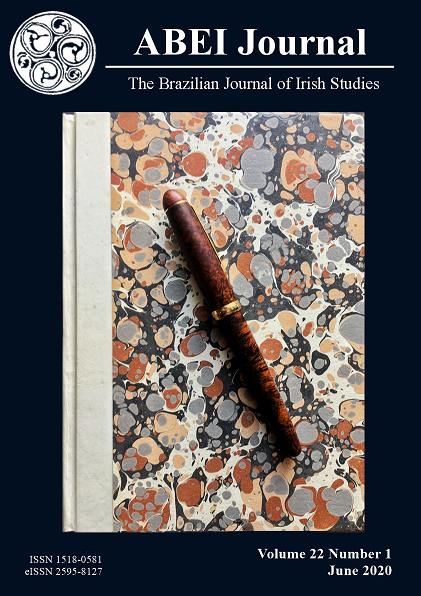Famine Roads and Big House Ghosts: History and Form in John Banville’s The Infinities
DOI:
https://doi.org/10.37389/abei.v22i1.3850Keywords:
Gothic, Famine, Big House, John Banville, Emily LawlessAbstract
This article considers John Banville’s engagement with memories of the Irish Famine and the conventions of the Irish Gothic and Big House novel in his 2009 novel The Infinities by comparing his approach to these topics to that of Emily Lawless in her considerably earlier 1897 collection Traits and Confidences. I argue that Banville’s engagement with the history of the Irish Famine and the conventions of the Irish Gothic and Big House novel are not incidental to the novel’s exploration of the problem of identity and the idea of the self but, rather, are fundamental to its thematic investments. Furthermore, I suggest that the novel’s experimental form fits into Irish literary tradition as Banville’s novel develops questions of identity, form, and content central to Lawless’s text.
References
Banville, John. Birchwood. Picador, 1973.
---. The Infinites. Picador, 2009.
---. “John Banville, The Art of Fiction No. 200”. Interview by Belinda McKeon. The Paris Review, issue 188, 2009, www.theparisreview.org/interviews/5907/john-banville-the-art-of-fiction-no-200-john-banville. Accessed on 6 January 2017.
---. “The Millions Interview: John Banville.” Interview by Anne K. Yoder. The Millions, themillions.com/2010/02/the-millions-interview-john-banville.html. Accessed 10 December 2019.
Cioséin, Niall O. “Was there ‘Silence’ About the Famine?” Irish Studies Review, vol. 4, no. 13, 1996, pp. 7-10, Taylor and Francis Online. DOI: 10.1080/09670889508455509. Accessed 10 December 2019.
Donnelly Jr., James S. “The Construction of the Memory of the Famine in Ireland and the Irish Diaspora, 1850-1900.” Éire-Ireland, vol. 31, no. 1-2, 1996, pp. 26-61, Project Muse, DOI: 10.1353/eir.1996.0002. Accessed 10 December 2019.
Fegan, Melissa. Literature and the Irish Famine 1845-1919. Oxford University Press, 2002.
Gibbons, Luke. Limits of the Visible: Representing the Great Hunger. Quinnipiac University Press, 2014.
Hand, Derek. John Banville: Exploring Fictions. Liffey Press, 2002.
Haslam, Richard. “Irish Gothic: A Rhetorical Hermeneutics Approach.” Irish Journal of Gothic and Horror Studies no. 2, 2007, pp. 3-26, https://irishgothichorror.files.wordpress.com/2018/03/richard-haslam.pdf. Accessed on 17 December 2019.
Imhof, Rüdiger. John Banville: A Critical Introduction. Wolfhound Press, 1989.
Kelleher, Margaret. The Feminization of Famine: Expressions of the Inexpressible? Cork University Press, 1997.
Kenny, John. John Banville. Irish Academic Press, 2009.
Killeen, Jarlath. The Emergence of Irish Gothic Fiction: History, Origins, Theories. Edinburgh University Press, 2014.
Kinealy, Christine. The Great Irish Famine: Impact, Ideology, and Rebellion. Palgrave MacMillan, 2002.
Kreilkamp, Vera. The Anglo-Irish Novel and the Big House. Syracuse University Press, 1998.
Lawless, Emily. “After the Famine.” Traits and Confidences. Garland Publishing, 1979, pp. 163-217.
---. “Famine Roads and Memory.” Traits and Confidences. Garland Publishing, 1979, pp. 142-62.
Lloyd, David. “The Indigent Sublime: Spectres of Irish Hunger. Irish Times: Temporalities of Modernity. Field Day, 2008. pp. 39-72.
McCormack, W.J. Dissolute Characters: Irish Literary History through Balzac, Sheridan Le Fanu, Yeats, and Bowen. Manchester University Press, 1993.
---. “Irish Gothic and After (1820–1945).” The Field Day Anthology of Irish Writing, Vol. 2, edited by Seamus Deane, Field Day Publications, 1991, 831-949.
Morash, Christopher. “Famine/Holocaust: Fragmented Bodies.” Éire-Ireland, vol. 32, no. 1, 1997, pp. 136-50, Project Muse, DOI: https://doi.org/10.1353/eir.1997.0008. Accessed on 10 December 2019.
Morin, Christina. The Gothic Novel in Ireland: c. 1760-1829. Manchester University Press, 2018.
Moynahan, Julian. Anglo-Irish: The Literary Imagination in a Hyphenated Culture. Princeton University Press, 1995.
Murphy, Neil. John Banville. Bucknell University Press, 2018.
Ó Gráda, Cormac. Black ’47 and Beyond: The Great Irish Famine in History, Economy, and Memory. Princeton University Press, 1999.
O’Malley, Patrick. Catholicism, Sexual Deviance, and Victorian Gothic Culture. Cambridge University Press, 2006.
Schwall, Hedwig. “An Iridescent Surplus of Style: Features of the Fantastic in Banville’s The Infinities.” Nordic Irish Studies, no. 9, 2010, pp. 89-107.
Smart, Robert. Black Roads: The Famine in Irish Literature. Quinnipiac University Press, 2015.
Downloads
Published
Issue
Section
License
Copyright (c) 2020 Cody D Jarman

This work is licensed under a Creative Commons Attribution-NonCommercial 4.0 International License.


